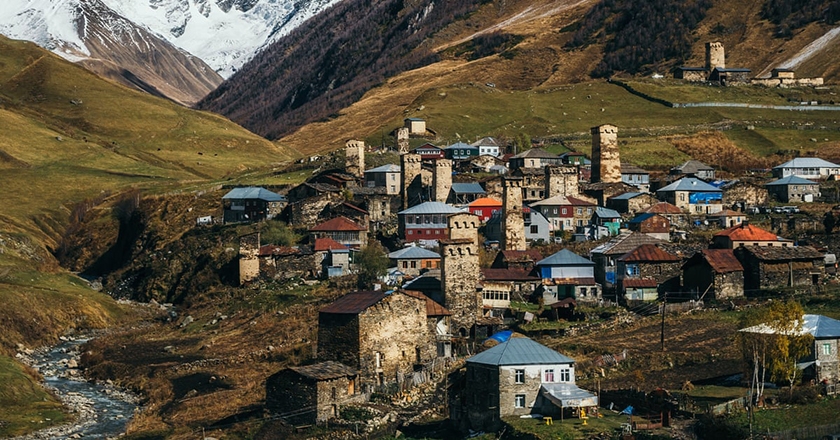Not many people would dare to visit Ushguli before 2004, terrified by robbers on the way to Svaneti. After the new government enforced the police to regain order in society, the villages of Upper Svaneti, also known as “living ethnographic museum,” quickly garnered international attention. In 2011 rehabilitation projects for Zugdidi-Mestia road and urban-type settlement, Mestia were completed, and travel time from Zugdidi to Mestia was shortened from 8 hours to 2.5. New Mestia airport was named among ten the most unusual airports in the world. Tourism became the main branch of economics in Svaneti. Mestia and Ushguli received more than 760000 visitors in 2015-2019.
The lack of infrastructure led locals to build new guesthouses without permission. There were no building regulations in Upper Svaneti. This process disfigured Mestia and Usghuli and created a new settlement near Chazhashi – Lamjurishi.
Tourism created a new source of income. Svans who have left Ushguli returned to their homes. The ones without inheriting property decided to build new houses. Not even older houses were left untouched. Owners enlarged their property and roofed them with iron sheets. In old times, Ushgulians only used rocks to build a house and wood shingle to roof it.
„If a person who has not lived in Ushguli for 30 years comes back and wants to build a house, I cannot approach them and tell them not to.“ - Kapiton Zhorzholiani, head of Mestia municipality, says that it is hard for him to reject building requests.
In 2017 government put a moratorium to stop and prohibit building in Ushguli. They have also promised locals to devise a development plan by the end of 2018. However, Mestia local assembly has not yet maintained a spatial arrangement document in 2021.
Nikoloz Antidze, Director-general of the National agency of heritage preservation of Georgia, explains that they have discussed the development plan with World Heritage Organization and sent their reprimands to the responsible company to improve or reject.
You visit the place and notice a new building. You return the next year and find out there are newer ones. We follow the law but cannot hide the truth – we cannot stop the process. Locals will understand the gravity of the situation if the danger of losing the world heritage status arises.
Characterless settlements with no architectural expressiveness greatly affected two villages – Chvibiani and Zhibiani.
Art historian Irine Elizbarashvili, who explores medieval Georgian architecture, says that the situation in Ushguli is catastrophic due to unpermitted construction.
In 2020 UNESCO monitoring mission should inspect the situation in Chazashi and decide whether the village would remain on the world heritage list or not. But, unfortunately, the visit was postponed due to the Covid-19 pandemic.
There are 41 towers, seven churches, and 87 machubs (old Svan houses) still standing in 4 villages of the Ushguli community. However, 700-1000-year-old constructions are facing a collapse now.
After losing defensive functions in the XIX century, towers slowly started to decay. Up to 150 towers and machubs in Upper Svaneti require urgent rehabilitation. Constructions in Ushguli, Mulakhi, and Adishi are facing the worst fate.
Village Murkmeli, the village of towers (Mukrvam means Towers in Svan language), is alarming. Out of 80 defensive towers, only ten lasted from the end of XIX to today. Eight of them have damaged roofs, and only one, the shortest of them all, was roofed by locals to stop rain leaking inside.
„You cannot find a single machub or a tower that does not require a restoration. First, the roof collapses, then water flows down along the walls, and our history crushes on our heads. Stones would fall out even not if there were not frozen. The tower of the Charkseliani family was half-destructed for years and almost caught us under the runs when it finally collapsed. People leave here. It’s dangerous. I was watching it collapse.
1000 lari is enough to cover a tower with iron sheets. Traditional roofing requires specialists and costs at least 10-15 times more; we cannot afford that.“ – Moses Tchelidze is 28. His family was relocated to Gardabani after the 1987 avalanche. Moses returned to Murkmeli 10 years ago and has been working as a guide until the pandemic struck.
Two avalanches hit Murkmeli in 1976 and 1987. Tens of houses were demolished, and several people dead. Mountains on the right bank of river Enguri are not covered with wood, and avalanches directly hit Murkmeli. Towers hit by the avalanche are still standing except for the one belonging to Charkseliani.
The government still has not done anything to establish avalanche control infrastructure.
The Director-general of the National agency of heritage preservation states that the scarcity of finances and lack of specialists hinder the rehabilitation process.






